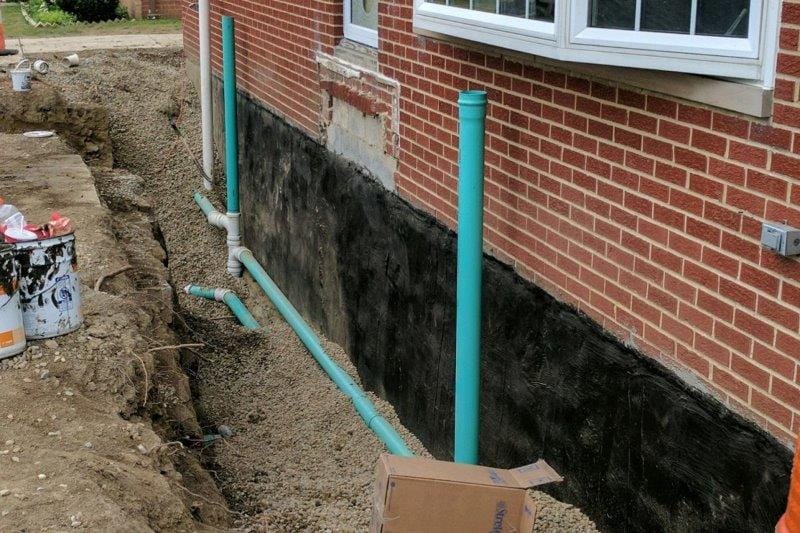The smart Trick of Best Basement Waterproofing That Nobody is Talking About
Table of ContentsBest Basement Waterproofing - The FactsBest Basement Waterproofing Can Be Fun For AnyoneMore About Best Basement WaterproofingNot known Details About Best Basement Waterproofing The 9-Second Trick For Best Basement Waterproofing
AdvantaClean's skilled specialists and service technicians will certainly find the water source. If wall or slab cracks are present, we will infuse polyurethane and epoxies right into the splits and secure the concession, stopping additional moisture from entering.If there's condensation on the exterior of the aluminum foil, you have high humidity in your basement. If the aluminum foil has condensation on the inside surface area (next to the wall surface), the dirt around your home might be naturally damp from a high water table or bad soil drain.
You can waterproof just your indoor wall surfaces, which may solve the issue. Once they dry out, they stick permanently to concrete and stonework wall surfaces.
Some Known Facts About Best Basement Waterproofing.
Concrete water resistant layers can not be applied to previously repainted surfaces; examine the tag. Recognized as densifiers, they are ideal just for wall surfaces that have not been repainted or sealed.
You clean, roll, or spray it on much even more heavily one gallon covers just 75 square feet, not the 300 square feet typical with typical paint. Water-proof paint is great for DIY application. You can use it over painted surface areas, and paint over it once it's healed (one gallon prices $37).
It can cost $10,000 to $15,000, depending on the job needed. Outside waterproofing includes digging deep into all around the home to the complete depth of the structure walls, after that setting up a waterproof layer or membrane topped by drain panels.
We've all been captured in a storm without umbrella or raincoat (Best Basement Waterproofing). And it's constantly a dish for disaster: everything's damp, your coiffure is spoiled, and things are obtaining moldy. A basement without waterproofing is kind of like that. Minus the spoiled hairdo part. Your basement doesn't desire to experience a downpour without correct security equally as much as you don't desire to.
Best Basement Waterproofing for Beginners
But if you've look at this website done your research, redirected here you would certainly understand there are 2 types of waterproofing: inside and outside. It can obtain puzzling what they both mean, which one's a far better financial investment, and what will really keep the water out. Don't fret, we created this blog site to quickly specify both approaches for you and go over the pros and disadvantages of each.
Outside waterproofing is a waterproofing approach that entails sealing your home from the exterior. It's type of like a moat around a castle. It involves digging a trench around your entire residence down to the foundation (about 8 to 10 feet down). The structure wall surfaces are then cleaned up, sealed, and covered with a waterproof membrane or sealer.

The Best Strategy To Use For Best Basement Waterproofing
It's a much more engaged process that requires digging up your yard, which is pricey and lengthy. Exterior waterproofing involves eliminating every little thing bordering your home, including patios, driveways, pathways, landscape design, air conditioning systems, decks, and so on. If any of the work was done incorrectly and water is still entering your cellar, there isn't much you can do to remedy or repair it.
Inside basement waterproofing includes waterproofing from the inside. Any type of water that leaks into your cellar is redirected before it touches your flooring. It's sort of like wearing a raincoat under your clothing. It involves 2 points: a water drainage track and a sump pump. It works by sealing the inside of your basement walls and floors so water that tries to enter is channeled out through a sump pump.
It's a reliable technique to water-proof your basement - Best Basement Waterproofing. The downside of indoor cellar waterproofing primarily pertains to the installment procedure. This approach requires kept products, furnishings, and integrated shelving or cupboards to be moved from touching the cellar wall surfaces. And throughout installment, your cellar can't be utilized. The most next significant distinction between both approaches is this: Outside waterproofing is a preventative remedy and indoor waterproofing is a corrective service.
4 Simple Techniques For Best Basement Waterproofing
Finally, exterior and interior cellar waterproofing are both efficient techniques of safeguarding your home from water damage. Outside waterproofing produces a barrier that stops water from entering your home, while indoor waterproofing reroutes water that does enter your home. And it is necessary to keep in mind that outside waterproofing is a costly and turbulent setup procedure when contrasted to interior waterproofing.
Whichever approach you choose, see to it you pick a trusted and credible contractor for the job. Both approaches need experienced workers to deal with the job. If you have any type of questions regarding cellar waterproofing, please get to out to us. And if you're in our solution area and have water in your basement, call us for a totally free, no-obligation home inspection.
You can fill up out our kind right here, start a chat in the bottom right-hand edge, or call us at 1-800-827-0702.